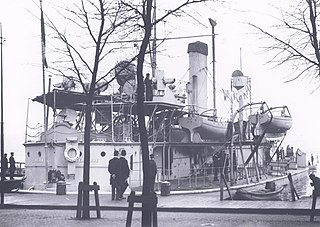Johannes Drost was a Dutch backstroke swimmer and diver who competed in the 1900 Summer Olympics.

Driebergen-Zeist is a railway station located between Driebergen and Zeist, the Netherlands. It is located in the municipality of Utrechtse Heuvelrug. The station was opened on 17 June 1844 and is located on the Amsterdam–Arnhem railway. The station is operated by Nederlandse Spoorwegen. In 2018 there were approximately 8,787 passengers per day using Driebergen-Zeist station. The station was renovated from 2017 to 2020.
Erik Borresen was a 19th-century Norwegian brig. The captain of the ship was captain J. C. Hesselberg. On 16 November 1849 the ship wrecked on De Westen, Texel, the Netherlands, drowning all ten people onboard.

Hotel Des Indes is a hotel located at the Lange Voorhout in The Hague, The Netherlands. It was constructed as a mansion in 1858. In 1881, it opened as a hotel.

HNLMS Cerberus, was a Heiligerlee-class monitor built in Amsterdam for the Royal Netherlands Navy in the 1860s. Cerberus was a true monitor: a ship with shallow draught, only a few (heavy) guns and decent armor. These characteristics made her very suitable to operate way inland in the Dutch delta.

HNLMS Adolf van Nassau was a unique ship built for the Royal Netherlands Navy.

SS Willem III was the lead ship of the Willem III class, and the first ship of the Stoomvaart Maatschappij Nederland (SMN). She was burnt on her maiden trip. Later the wreck was repaired and sailed as Quang Se, Glenorchy and Pina.

SS Prins van Oranje was the second ship of the Willem III class. It was the first ship of the Stoomvaart Maatschappij Nederland (SMN) that completed a round trip to the Dutch East Indies.

SS Prins Hendrik was the third ship of the Willem III class. She was the second ship of the Stoomvaart Maatschappij Nederland (SMN) and was lost after barely two years of service.

HNLMS Matador was a monitor built in the late 1870s.

Amsterdamsche Droogdok Maatschappij (ADM) was a Dutch company that repaired ships using dry docks in Amsterdam, Netherlands. After World War II it also built some ships.

L. Smit en Zoon previously known as Fop Smit, was a Dutch shipbuilding company located in Kinderdijk. Its successor is now part of Royal IHC.
Laurdal was a Norwegian barque in the 19th-century.
SS Alesia was a 5,114 GRT steamship built in 1896. In 1923 she wrecked at Texel, the Netherlands.
Revolving Light sometimes written as Revolvinglight was a barque launched from the Turner Shipyard in Harvey Bank, New Brunswick on 15 September 1875. The ship was 196 feet (60 m) long and had a tonnage of 1,338 tons. The ship was the first ship of the Turner Shipyard of Gaius Samuel Turner.
SS Millbank sometimes wrongly written as SS Millbanke was a 1865 built British steamship. The ship weighed 548 BRT. Its home port was Sunderland. The ship was owned by R.M. Hudson. The captain of the ship was Smith. In November 1866 the ship wrecked at the Netherlands. The crew was saved by another ship.
SS Octa was a 1861 built British steamship. The ship had a tonnage of 569 gross register tons (GRT). It was owned by Norwood C. M. & Co. in Hull. On 1 May 1871 the ship was driven ashore and wrecked on Terschelling, the Netherlands. The 19 crew members were rescued.
Lisette was an 1881-built, 50-metre long German three-masted iron schooner. It was owned by Johan Georg Oestman and had hometown Blankenese.
SS Aline Woermann was a 1879 Reiherstieg Schiffswerfte & Maschinenfabrik built 74 metres long German steamship. It was owned by the Woermann-Linie of Carl Woermann having Hamburg as hometown. She was deployed on a scheduled service between Hamburg, Liberia and Cameroon.












